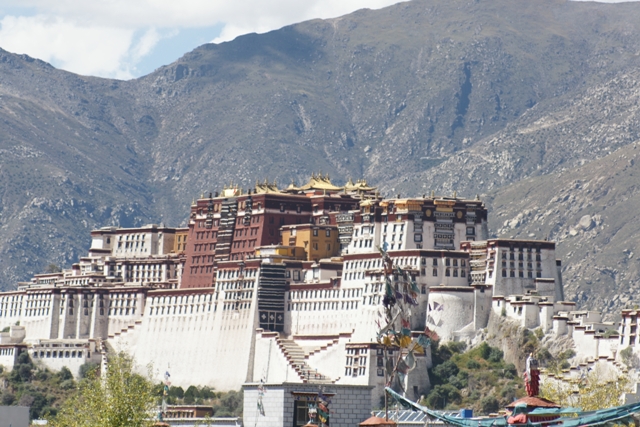Support our humanitarian projects for the Chinese minorities with your trip
China officially registers 56 ethnic groups. The Han Chinese constitute about 92 percent of the population of mainland China. The minorities account for a small 8 percent of the entire population, that live from the hinterlands of the north to the lush jungles in the south, and from the mountains of Taiwan to the top of the world in the west. There are five autonomous regions in China: Guangxi, Xinjiang, Tibet, Ningxia and Inner Mongolia.
Tour to the Minorities in Guangxi and Guizhou:
13 days China Southwestern Minorities Discovery Tour
Minority Tour from Tibet to Nepal:
9 days spiritual Tour from Lhasa to Kathmandu
The ethnic groups of China are distinguished by their different traditions and customs in marriage, childbirth, funerals, festivals, food, housing, costume, hosting guests and recreational activities.
Do you have a question? Use our online support system! Simply click on the "live chat" icon, fill in the required fields and choose an available operator.
Religion still has a wide influence throughout the ethnic minority areas. Lamaism has its followers mostly among the Mongolian, Tibetan, Tus and Yugur. Hinayana has believers mainly among such ethnic groups as the Bai, Dai, De'Ang, Achang, Bulang, Jingpo and some of the Wa. Islam has followers among ten ethnic groups: the Hui, Uigur, Kazak, Tatar, Kirgiz, Tajik, Ozbek, Dongxiang, Salar and Bonan. Protestantism found converts among the Miao and Yi, and some ethnic minorities living in western Yunnan. Believers in the Orthodox Eastern Church are found among small groups of Russians and Ewenki. Primitive fetishism and polytheism, ancestor worship, totemism and shamanism still has believers among ethnic minority groups as the Dulung, Nu, Wa, Shui, Dong, Bouyei, Jingpo, Gaoshan, Oroqen, Miao, Jinuo and Pumi.

While hundreds of Chinese dialects are spoken across China, a minority language is not simply a dialect. Rather, it is a language with distinct grammatical and phonological differences from Chinese. Language families include Sino-Tibetan, Altaic, Indo-European, Austro-Asiatic, and Austronesian. Twenty-one ethnic minority groups have unique writing systems.
If you really want to get to know China, you will have to leave the beaten track and travel to remote areas, where you will get in touch with the numerous minorities. You will stay overnight at local families' homes, where you will gain insight into their daily lives and have a unique and authentic experience.
Particularly the southwest comprises a multitude of minorities living in the provinces of Guizhou, Guangxi, Sichuan and Yunnan, where we will take you to the matrilineal societies of Naxi and Mosuo. In Sichuan you will visit the Yi, Pumi and the Tibetans and discover the Miao with their colorful and diligently adorned costumes, the impressive architectural style of the Dong and the frugal way of life of the Zhuang living in Guizhou and Guangxi. Furthermore, we will follow the traces of shamans and herbal medicinists amidst impressive scenery.
You will get in direct touch with the local people but without exerting a negative influence on their culture. With a part of our profit we will support humanitarian projects in the areas we visit. Your trip will therefore contribute to the improvement of the quality of life in a sustainable way.
Tourism may have a positive or negative impact on touristically underdeveloped areas. Hidden China's philosophy is to promote sustainable, ecological tourism and to contribute to the welfare of these regions as well as to positively influence the touristic development with our personal contacts and knowledge.
Ethnic minority groups in China (in alphabetical order)
| ethnic group | living in |
| Achang | Yunnan |
| Bai | Yunnan, Guizhou |
| Bao'An | Gansu |
| Bouyei | Guizhou |
| Bulang | Yunnan |
| Dai | Yunnan |
| Daur | Inner Mongolia, Heilongjiang, Xinjiang |
| De'Ang | Yunnan |
| Dong | Guizhou, Hunan, Guangxi |
| Dongxiang | Gansu, Xinjiang |
| Dulung | Yunnan |
| Ewenki | Heilongjiang, Inner Mongolia |
| Gaoshan | Taiwan, Fujian |
| Gelao | Guizhou, Guangxi |
| Hani | Yunnan |
| Hezhen | Heilongjiang |
| Hui | Ningxia, Gansu, Henan, Hebei, Qinghai, Shandong, Yunnan, Xinjiang, Anhui, Liaoning, Heilongjiang, Jilin, Shaanxi, Beijing, Tianjin |
| Jing | Guangxi |
| Jingpo | Yunnan |
| Jinuo | Yunnan |
| Kazak | Xinjiang, Gansu, Qinghai |
| Kirgiz | Xinjiang, Heilongjiang |
| Korean | Jilin, Liaoning, Heilongjiang |
| Lahu | Yunnan |
| Li | Hainan |
| Lisu | Yunnan, Sichuan |
| Luoba | Tibet |
| Manchu | Liaoning, Jilin, Heilongjiang, Hebei, Beijing, Inner Mongolia |
| Maonan | Guangxi |
| Menba | Tibet |
| Miao | Guizhou, Hunan, Yunnan, Guangxi, Sichuan, Hainan, Hubei |
| Mongolian | Inner Mongolia, Xinjiang, Liaoning, Jilin, Heilongjiang, Gansu, Hebei, Henan, Qinghai |
| Mulao | Guangxi |
| Naxi | Yunnan, Sichuan |
| Nu | Yunnan |
| Oroqen | Inner Mongolia, Heilongjiang |
| Ozbek | Xinjiang |
| Pumi | Yunnan |
| Qiang | Sichuan |
| Russian | Xinjiang |
| Salar | Qinghai, Gansu |
| She | Fujian, Zhejiang, Jiangxi, Guangdong |
| Shui | Guizhou, Guangxi |
| Tajik | Xinjiang |
| Tatar | Xinjiang |
| Tibetan | Tibet, Qinghai, Sichuan, Gansu, Yunnan |
| Tu | Qinghai, Gansu |
| Tujia | Hunan, Hubei |
| Uigur | Xinjiang |
| Wa | Yunnan |
| Xibe | Xinjiang, Liaoning, Jilin |
| Yao | Guangxi, Hunan, Yunnan, Guangdong, Guizhou |
| Yi | Sichuan, Yunnan, Guizhou, Guangxi |
| Yugur | Gansu |
| Zhuang | Guangxi, Yunnan, Guangdong, Guizhou |





